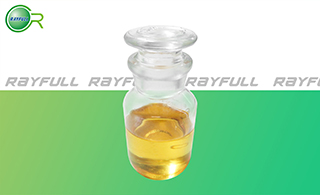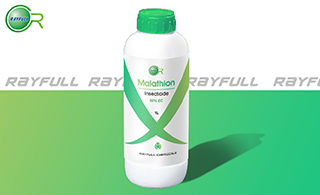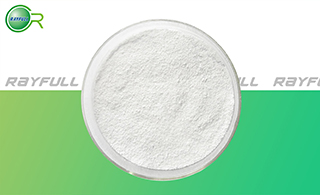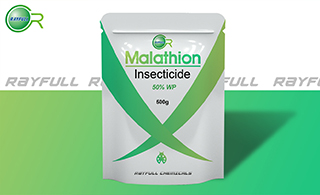Malathion
    马拉硫磷 马拉硫磷
Introduction: Malathion is a non-systemic, wide spectrum insecticide. It was one of the earliest organophosphate insecticides developed (introduced in 1950). Malathion is suited for the control of sucking and chewing insects on fruits and vegetables. Malathion is also used to control mosquitoes, flies, household insects, animal parasites (ectoparasites) and head and body lice. Malathion is a general use pesticide.
Common name: Malathion
Another name: Mercaptothion; Carbofos; Karbofos; Maldison; Carbafos; Carbofos; Carbophos; Cythion; Karbofos; Prioderm; Sadophos etc.
Chemical Name (IUPAC): diethyl (dimethoxyphosphinothioylthio)succinate
Structural formula:

Empirical formula: C10H19O6PS2
Mol. Weight: 330.36
CAS No.: 121-75-5
Specifications
Leading Malathion supplier
Malathion 95% TC
Malathion 96% TC
Malathion 50% EC
Malathion 50% WP
Packing
BULK PACKING
Powder: 25KG/Bag, 25KG/Drum, 50KG/Drum etc.
Liquid: 200L/Drum, 20L/Drum, 10L/Drum ect.
SMALL PACKING
Powder: 1kg/Alu bag, 500g/Alu bag, 200g/Alu bag, 100g/Alu bag, 50g/Alu bag, 15g/Alu bag etc.
Liquid: 5L/Drum, 1L/Bottle, 500ml/Bottle, 250ml/Bottle, 100ml/Bottle, 50ml/Bottle etc.
Customerized Packing label
Malathion FAO standard
Professional registration
HAZARDS IDENTIFICATION
Hazard statement(s)
H302: Harmful if swallowed.
H317: May cause an allergic skin reaction.
H350: May cause cancer.
H400: Very toxic to aquatic life.
H410: Very toxic to aquatic life with long lasting effects.
Precautionary statement(s)
P201: Obtain special instructions before use.
P202: Do not handle until all safety precautions have been read and understood.
P261: Avoid breathing {dust/fume/gas/mist/vapors/spray}.
P264: Wash {hands} thoroughly after handling.
P272: Contaminated work clothing should not be allowed out of the workplace.
P301+312: IF SWALLOWED: Call a POISON CENTER or doctor/physician if you feel unwell.
P302+352: IF ON SKIN: Wash with plenty of soap and water.
P391: Collect spillage.
P501: Dispose of contents/container as hazardous waste.
Supplemental Hazard Statements: none.
MAMMALIAN TOXICOLOGY
Acute toxicity: 1) Acute oral LD50 for rats is 1778 mg/kg. 2) Acute percutaneous LD50 for rats is >2000 mg/kg. 3) Acute inhalation toxicity LC50 (4 h) for rats is >5.0 mg/l. 4) Skin irritation: Non-irritating to skin (rabbits). 5) Eye irritation: Slightly irritating to eyes (rabbits). 6) Skin sensitization for guinea pig: Not a skin sensitiser.
NOEL: NOEL (2 y) for rats is 29 mg/kg/day; NOEL (18 m) for mice is 140 mg/kg/day; NOEL (1 y) for dogs is 125 mg/kg/day. Other Not carcinogenic. Not mutagenic or genotoxic.
ADI (JMPR) 0-0.3 mg/kg b.w.[1997, 2003]
Classification:
WHO Classification: III (Slightly hazardous)
EC Risk Classification: Xn - Harmful: R22, R43; N - Dangerous for the environment: R50, R53.
US EPA Classification (formulation): III (Caution - Slightly toxic)
ECOTOXICOLOGY
Effect on birds: Acute oral LD50 for Bobwhite quail is 359 mg/kg. Effect on fish: Acute LC50 (96 h) for Rainbow trout is 0.018 mg/l. Effects on aquatic invertebrates: Acute EC50 (48 h) for Daphnia magna is 0.0007 mg/l. Effects on algae: Acute EC50 (72 h) for Raphidocelis subcapitata is 13 mg/l. Effects on bees: Contact acute (48 h) LD50 is 0.16 μg/bee, Oral acute (48 h) LD50 is 0.40 μg/bee. Effects on earthworms: Acute 14 day LC50 is 306 mg/kg.
ENVIRONMENTAL FATE
If released to air, a vapor pressure of 3.97×10-5 mm Hg at 30℃ indicates malathion will exist in both the vapor and particulate phases in the atmosphere. Vapor-phase malathion will be degraded in the atmosphere by reaction with photochemically-produced hydroxyl radicals; the half-life for this reaction in air is estimated to be 5 hours. Particulate-phase malathion will be removed from the atmosphere by wet and dry deposition. Malathion contains chromophores that absorb at wavelengths >290 nm and, therefore, may be susceptible to direct photolysis by sunlight. If released to soil, malathion is expected to have low to no mobility based upon Koc values of 927-17,620. Volatilization from moist soil surfaces is not expected to be an important fate process based upon a Henry's Law constant of 4.89×10-9 atm-cu m/mole. Malathion is not expected to volatilize from dry soil surfaces based upon its vapor pressure. The degradation half-life of malathion in five different soils was 1.33-4.14 days. Malathion was degraded 81-94% in 10 days in various non sterile loam soils. If released into water, malathion is expected to adsorb to suspended solids and sediment based upon the Koc values. The degradation half-life of malathion in different types of water was 1.03-3.93 days. Photodegradation may compete with hydrolysis and biodegradation based on a study finding a photolysis half-life of 533 minutes. Volatilization from water surfaces is not expected to be an important fate process based upon this compound's reported Henry's Law constant. Malathion did not bioconcentrate in topmouth gudgeon or pinfish suggesting bioconcentration in aquatic organisms is low. Hydrolysis is the main route of malathion degradation in water with pH >7.0; at pH <7.0, the rate of hydrolysis is slow relative to the rate of biodegradation. Occupational exposure to malathion may occur through inhalation and dermal contact with this compound at workplaces where malathion is produced or used. Monitoring data indicate that the general population may be exposed to malathion via inhalation of ambient air, ingestion of food and drinking water, and dermal contact with consumer products containing malathion.
Usage: Malathion was developed by American Cyanamid Company. Malathion is used to control a broad spectrum of insects including: ants, aphids, fleas, fruit flies, hornets, mites, mosquitoes, moths, spiders, thrips, ticks, wasps, and weevil. Malathion is used for pest control on a wide range of agricultural food and feed crops, the most common of which are blueberries, raspberries, strawberries, limes, cotton, cherries, garlic, greens, dates and celery.
Application: Mode of action Non-systemic insecticide and acaricide with contact, stomach, and respiratory action. Uses Used to control Coleoptera, Diptera, Hemiptera, Hymenoptera and Lepidoptera in a wide range of crops, including cotton, pome, soft and stone fruit, potatoes, rice and vegetables. Used extensively to control major arthropod disease vectors (Culicidae) in public health programmes, ectoparasites (Diptera, Acari, Mallophaga) of cattle, poultry, dogs and cats, human head and body lice (Anoplura), household insects (Diptera, Orthoptera), and for the protection of stored grain. Typical application rates for agricultural uses 0.5-1.25 kg/ha. Phytotoxicity Non-phytotoxic in general, if used as recommended, but glasshouse cucurbits and beans, certain ornamentals, and some varieties of apple, pear, and grape may be injured.
| 






